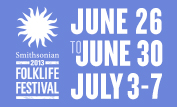
The One World, Many Voices: Endangered Languages and Cultural Heritage Festival program is currently highlighting language diversity as a vital part of our human heritage. Cultural experts from communities around the world are gathering to demonstrate how their ancestral tongues embody cultural knowledge, identity, values, technologies, and arts.
Through performances, craft demonstrations, interactive discussion sessions, community celebrations, and hands-on educational activities, musicians, storytellers, singers, dancers, craftspeople, language educators, and other cultural practitioners are coming together on the National Mall to share their artistry, knowledge, and traditions; to discuss the meaning and value of their languages to their cultural heritage and ways of life; and to address the challenges they face in maintaining the vitality of their languages in today’s world.
Festival visitors can talk with Kalmyk epic singers and Tuvan stone carvers from Russia, Koro rice farmers from India, Passamaquoddy basketmakers from Maine, Kallawaya medicinal healers and textile artists from Bolivia, Garifuna drummers and dancers from Los Angeles and New York, and many others.
When a language disappears, unique ways of knowing, understanding, and experiencing the world are lost forever. The expert culture bearers participating in the One World, Many Voices program richly illustrate these different ways of knowing and show how cultural and language diversity enrich the world.
The One World, Many Voices program was produced by the Smithsonian Center for Folklife and Cultural Heritage in collaboration with UNESCO, the National Geographic Society’s Enduring Voices Project, and the Smithsonian’s Recovering Voices Initiative.
Resources:
Living Tongues Institute for Endangered Languages documents, preserves, and revitalizes endangered languages worldwide through linguist-aided, community-driven multi-media language documentation projects and the development of talking dictionaries. http://www.livingtongues.org
National Geographic Society’s Enduring Voices is a joint project with the Living Tongues Institute for Endangered Languages that documents languages and prevents their extinction by identifying crucial areas where languages are endangered. http://travel.nationalgeographic.com/travel/enduring-voices
Smithsonian’s Recovering Voices Initiative, led by the Smithsonian’s National Museum of Natural History in partnership with National Museum of the American Indian and Center for Folklife and Cultural Heritage, promotes the documentation and revitalization of the world’s endangered languages through research, collaboration, and resources. http://anthropology.si.edu/recovering_voices/index.htm
UNESCO Atlas of the World’s Languages in Danger is an interactive atlas enabling viewers to browse through the world’s endangered languages using various search criteria or by clicking on a world map. http://www.unesco.org/culture/languages-atlas
UNESCO Endangered Languages Programme monitors and assesses the status and trends in linguistic diversity, and supports advocacy, technical expertise, and training. http://www.unesco.org/new/en/culture/themes/endangeredlanguages


